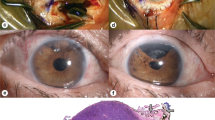Summary
BACKGROUND: 1. To report about late endoresection to treat a long standing retinal detachment with a regressed uveal melanoma and a beginning neovascular glaucoma; 2. to investigate the reasons for a long standing retinal detachment and neovascular glaucoma after single fraction radiosurgery. PATIENTS AND METHOD: 5 patients with a large uveal melanoma and a median tumor prominence of 9,3 mm (7,6–10,4 mm), a median basal diameter of 13 mm (12–17 mm) were treated with a single fraction Gamma Knife radiosurgery with a marginal dose of 30 Gy. Prior to therapy all tumors had a retinal detachment of one to two quadrants. After radiosurgery besides sufficient tumor control all patients experienced a (nearly) total retinal detachment lasting between 3–18 months. In all patients neovascularisations of the irs, in 2 patients secundary glaucoma developed. Phacoemulsification, pars plana vitrectomy with retinotomy, endoresection and silicon oil tamponade were performed in all patients as an alternative therapy to enucleation. RESULTS: After surgery intraocular pressure normalised in all but one eye (1/5 had recurrant bleeding and developed rapid neovascularisation of the iris after resorption of the blood), in 3/5 silicon oil was removed. Intraocular pressure was normal in 4/5 after a follow up of 27 months, retina was reattached in 4/5 (in one patient a residual peripheral PVR reaction occured, which did not progress so far). CONCLUSION: Late endoresection with silicon oil assisted reattachment could preserve all eyes with long standing retinal detachment in a regressed large melanoma even in case of a beginning neovascular glaucoma. Risk factors for a long standing retinal detachment with neovascularisations of the anterior and posterior segment were 1. a retinal detachment of 1–2 quadrants prior to therapy; 2. a high dose rate of the new cobalt sources of the Gamma Knife; 3. a large tumor volume. Despite sufficient tumor regression and preservation of the globe visual acuity remains poor.
Zusammenfassung
HINTERGRUND: Die Therapie einer persistierenden Amotio und/oder eines Neovaskularisationsglaukoms nach Bestrahlung eines Aderhautmelanoms bestand bisher in der Enukleation des Tumorauges. Nachdem in den letzten Jahren mehrere Autoren über die Endoresektion (Entfernung des Tumors über Vitrektomietechniken) von Aderhautmelanomen berichtet hatten, haben wir bei 5 PatientInnen mit lang bestehender Amotio alternativ zur Enukleation die Endoresektion und operative Wiederanlage der Netzhaut mittels Vitrektomie durchgeführt und die Gründe für eine lang bestehende postoperative Amotio mit beginnendem Neovaskularisationsglaukom untersucht. PATIENTEN UND METHODE: Die großvolumigen Aderhautmelanome hatten eine mediane Prominenz von 9,3 mm (7,6–10,4 mm), einen medianen Durchmesser von 13 mm (12–17 mm) und wurden alle einzeitig mit dem Leksell-Gamma-Knife behandelt. Zwei dieser Patienten litten an einem großen Ziliarkörpermelanom. Präoperativ hatten alle PatientInnen eine Begleitamotio über 1–2 Quadranten, postoperativ war bei allen PatientInnen eine persistierende Amotio bis zu länger als einem Jahr auffallend, die in allen Fällen zu Neovaskularisationen der Iris, bei zwei Patienten zu einem Neovaskularisationsglaukom und einem maximalen Augendruck von 30 mm Hg führte. Alternativ zur früher praktizierten Enukleation wurde bei diesen Patienten der vorbestrahlte Tumor teilweise oder nahezu vollständig über eine Vitrektomie entfernt, die Netzhaut definitiv unter Silikonöl angelegt. RESULTATE: Der Augendruck lag postoperativ in 4 von 5 Augen im Normbereich, die Netzhaut war bis auf einen Fall mit peripherer Traktion allseits anliegend. Das Silikönöl wurde bisher bei 3 Augen wieder entfernt, bei 2 weiteren wurde das Silikonöl belassen. Bei zwei Patienten sind neuerliche Neovaskularisationen der Iris aufgetreten. SCHLUSSFOLGERUNG: Eine vorbestehende Begleitamotio über ein bis zwei Quadranten bei großen Tumorvoluminae war offensichtlich in allen Fällen eine der Hauptursachen für eine lange bestehende postoperative Amotio, die letztendlich zur Rubeosis geführt hat. Die späte Endoresektion und operative Wiederanlage der Netzhaut mittels Vitrektomie unter Silikonöl mit teilweiser oder vollständiger Endoresektion des vorbestrahlten Tumors hat nach einer kurzen Verlaufsbeobachtungsdauer den Organerhalt bei ausreichender Tumorregression aller Augen ermöglicht, eine für den Patienten brauchbare Sehfunktion konnte jedoch nicht erzielt werden.
Similar content being viewed by others
Literatur
Bechrakis NE, Hocht S, Martus P, Kreusel KM, Heese J, Foerster MH (2004) Endoresection following proton beam irradiation of large uveal melanomas. Ophthalmologe 101 (4): 370–376
Bornfeld N, Talies S, Anastassiou G, Schilling H, Schuler A, Horstmann GA (2002) Endoscopic resection of malignant melanomas of the uvea after preoperative stereotactic single dose convergence irradiation with the Leksell gamma knife. Ophthalmologe 99 (5): 338–344
Damato B, Groenewald C, McGalliard J, Wong D (1998) Endoresection of choroidal melanoma. Br J Ophthalmol 82 (3): 213–218. Comment Br J Ophthalmol 1998 82 (3): 209
Damato B, Wong D, Green FD, Mackenzie JM (2001) Intrascleral recurrence of uveal melanoma after transretinal "endoresection". Br J Ophthalmol 85 (1): 114–115
Garcia Arumi J, Sararolis L, Martinez V, Corcostegui B (2001) Vitreoretinal surgery and endoresection in high posterior choroidal melanomas. Retina 21: 445–451
Langmann G, Pendl O, Schröttner G (1995) Die radiochirurgische Therapie mit der Leksell-Gamma-Einheit in der Behandlung von Aderhautmelanomen. Spektrum Augenheilkd 9: 16–21
Langmann G, Pendl G, Müllner K (2002) High-compared with low-dose radiosurgery for uveal melanomas. J Neurosurg 97[Suppl 5]: 630–643
Mueller AJ, Talies S, Schaller UC (2000) Stereotactic radiosurgery of large uveal melanomas with the Gamma Knife. Ophthalmology 107: 1381–1388
Peyman GA, Cheema RA, Lagouros PA (2001) Endoresection of a ciliochoroidal melanoma. Can J Ophthalmol 36 (7): 411–414; discussion 414–415
Robertson D (2001) Melanoma endoresection: a perspective. Retina 21: 403–407
Schmidt JC, Brieden-Azvedo S, Nietgen GW (2001) Therapy of radiation resistant malignant uveal melanoma with endoresection by pars plana vitrectomy in two patients. Klin Monatsbl Augenheilkd 218 (12): 800–804
Zehetmayer M, Kitz K, Menapace R (2000) Local tumor control and morbidity after one to three fractions of stereotactic external beam irradiation of melanoma. Radiother Oncol 55 (2): 135–144
Author information
Authors and Affiliations
Corresponding author
Rights and permissions
About this article
Cite this article
Langmann, G., Schmutzer, M., Mattes, D. et al. Endoresektion von vorbestrahlten Aderhautmelanomen als Therapie einer persistierenden Amotio mit (beginnendem) Neovaskularisationsglaukom. Spektrum Augenheilkd. 21, 179–182 (2007). https://doi.org/10.1007/s00717-007-0206-0
Issue Date:
DOI: https://doi.org/10.1007/s00717-007-0206-0
Key words
- Uveal melanoma
- Late endoresection
- Gamma Knife radiosurgery
- Long standing retinal detachment
- Neovascular glaucoma




